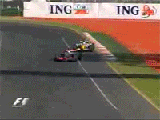Hi Jonathan, welcome
to the forum. The basic principle of drafting is fairly straightforward and one doesn't need a racecar - or a car at all, for that matter - to personally experience what a reduction in wind resistance means. It is not advisable, though, to go around tailgating people on public roads in the name of gathering empirical data! For your first question, the answer is manyfold but if you're willing to put an hour or two into reading a couple of technologically minded articles (I'll suggest a couple later), you'll propably already know more about the subject than 95% F1 fans in general care about.
In short, what's certain is that there's a clearly measurable and significant effect some 40m (roughly the same in yd) behind the leading car at 200mph (320kph) and drivers have claimed that they begin to feel the difference at around a 100 meters distance.
As to your second question, if the following car is close enough, yes, there is a slight advantage (0.4% at half a car's distance), but if the chasing car is four car lengths down, the leading car's L/D (lift to drag ratio, even if it's "negative lift") is adversely affected and it's a disadvantage. If the gap is eight car lengths or more, there's no meaningful effect on the leading car. So, drafting "done correctly" as far as the leading car is concerned, happens at very short distances (albeit I'm sure the driver would be happier if he hadn't a fellow competitor so close by ...) whereas the chasing driver will be happy to draft in a straight line and considerably less so in a high DF (downforce) curve where he would sorely need the front end grip that is missing.
I think you have slightly misunderstood the concept of "dirty air". When slipstreaming/drafting, you're always in "dirty" air i.e. in a flow affected by another competitor. It is called dirty since it's an unpredictable environment for the driver to be in - the aerodynamical balance and thus the grip changes. The flow and the downwash from the leading car isn't vertically or horizontally uniform and there are abrupt changes in the energy of the airflow that are evident only by the vehicle's interaction with vortices and such. So "dirty air", I think, isn't merely a question of aerodynamical force, but its nature.

Now, where I'm getting all this from? Here goes:
An ever so slightly outdated article about overtaking in F1, from grandprix.com, 1995:
Overtaking in Formula 1
Two articles on the (aforementioned) Advantage CFD study from 2004, first one from a Fluent paper:
Motor Sport Drives CFD Technology to a New Level
It's a PDF, 2.44 megs, you want to start reading from page 8, "Transient Manoeuvres"
The second one an article from Racecar Engineering (an excellent publication), again a PDF, 0.46 megs:
Draft dodging
Obviously there are also very talented contributors on F1Technical and as the issue of slipstreams, dirty air and overtaking is constantly discussed there are some excellent examples of lateral thinking to be found in the discussions, like from
reca here:
F1 aerodynamics, drafting and dirty air, page 2
Not to mention how much effort Miqdad Ali (a.k.a.
miqi23) put into investigating the merits of the CDG (Centerline Downwash Generating) wing, put forward by the FIA some time ago - and this goes very much into slipstreaming:
Aerodynamic study of the CDG concept
The FIA's new CDG wing
I think you'll find yourself entertained for a while just by going through those, for starters. I hope I got all the links correctly.
Edit: Obviously, the velocities must not be very great for drafting to work - just think about cycling and how the teams protect and aid their main contender with drafting, or how cyclists in general can co-operate by forming different "competitive units" - or how quickly a single cyclist that loses touch to his group drops behind. Here's a link (a bit off topic):
Science of cycling: Aerodynamics: page 2
The priciple is exactly the same, though. I came to think of this only because of
Ciro's excellent link (below), the article about NASCAR "social sciences" is -definitely- worth reading and perhaps could also offer clues about how F1 could encourage a more "social" approach to racing in general as opposed to encouraging the very selfish one that is so prevalent today. But anyway, going back to cycling, apparently I needed a couple of dormant synapses reconnected ... after having a rather sudden and violent encounter with a car some years ago (a bike is no match, as if my direct experience would make that more obvious), I've found that certain negative connotations can cause an unconscious but eventually noticeable aversion to making certain associations.







